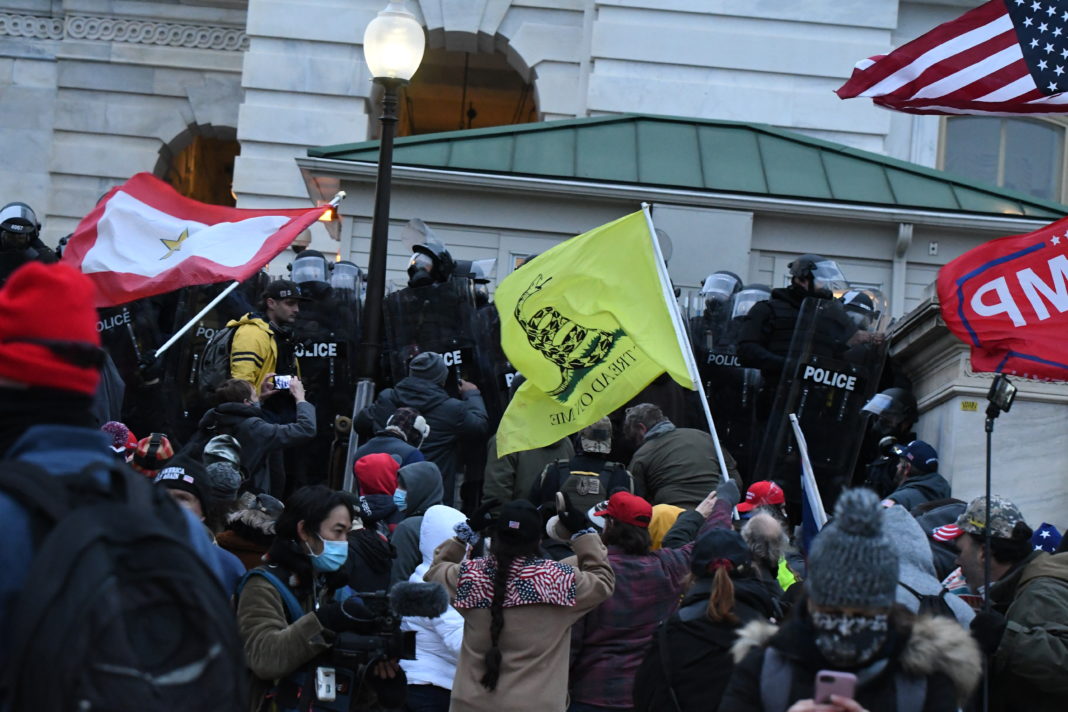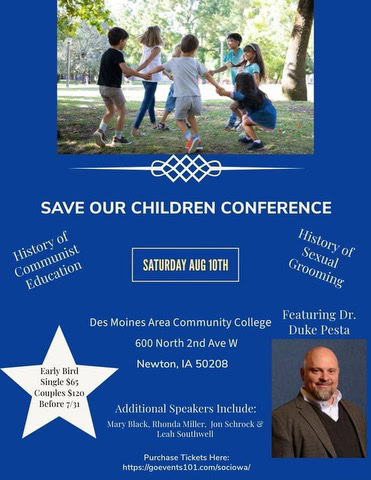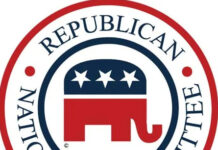Steven Sund, the former chief of Capitol Police, sent a letter to congressional leaders earlier this month.
Sund wrote that “nothing in our collective experience or our intelligence” indicated a well-coordinated, armed assault on the Capitol might occur on Jan. 6.
Sund noted that the agency handled post-election protests on Nov. 14 and Dec. 12.
“As we prepared for the third protest, we understood that the focus of the protests would be the Capitol itself,” Sund wrote.
All the intelligence reports led Capitol Police to believe Jan. 6 would be similar to the previous two protests.
Intelligence reports stated the level of probability of acts of civil disobedience/arrests occurring based on current information was “remote” to “improbable” for all of the groups expected to demonstrate.
The Daily Intelligence report indicated the Secretary of Homeland Security hadn’t issued an elevated or imminent alert either.
Sund placed an “all hands on deck” status on the Jan. 6 Joint Session of Congress.
“We activated the largest number of CDU platoons possible while still supporting the Joint Session of Congress,” Sund wrote.
That decision led to the activation of seven CDU platoons (approximately 250 officers), with four platoons being available in hard gear — helmets, protective clothing and shields.
“While limited by budgetary and training restraints imposed on USCP, the planned number of CDU officers had always sufficed for large demonstrations on Capitol Hill prior to Jan. 6.”
On Jan. 2, Sund contacted MPD Chief Robert Contee to discuss Jan. 6. On the morning of Jan. 6, Sund exchanged information with MPD Assistant Chief Jeffery Carroll regarding the designated CDU Incident Command.
“This was done in an effort to facilitate immediate command and control of assets if requested,” Sund said.
Sund developed an expanded perimeter based on concern for First Amendment activity focused on the Capitol and the “large number of people expected.”
“It was the heightened tensions related to the certification of the vote, and the expanded perimeter that made me believe that National Guard assistance might be necessary,” he wrote.
On Jan. 4, Sund approached the two Sergeants at Arms to request the assistance of the National Guard. Sund had no authority to do so without an Emergency Declaration by the Capitol Police Board.
The House Sergeant at Arms said he was concerned about the optics and didn’t believe intelligence supported it. The Senate Sergeant at Arms asked how quickly Capitol Police could get support if necessary.
General William Walker, the commanding officer of D.C. National Guard, told Sund he could repurpose 125 National Guard and have them to the Capitol quickly once approved.
During a Jan. 5 meeting with Sund’s executive team, all three principals of the Capitol Police Board and a dozen top law enforcement and military officials from D.C. (including the FBI, Secret Service and National Guard), not a single entity provided any intelligence indicating there would be a coordinated violent attack on the Capitol.
“In fact, all present at the meeting indicated that there was no new intelligence to report for Jan. 6,” he wrote. “At no time did the Department of Homeland Security issue a threat advisory bulletin in reference to violent extremists planning a coordinated, violent attack on the U.S. Capitol.”
Sund said that contrary to allegations made to the media, he did not “misrepresent any facts to Members” of Congress.
Sund called MPD Inspector Robert Glover at 7:15 a.m. on his way to work on Jan. 6. Glover said lines were already forming, but the crowd was compliant and he did not observe any concerning issues.
There were no concerns with the actions and demeanor of the crowd as of 12:52 p.m., Sund wrote, when they received word that a pipe bomb was located at the Republican National Committee headquarters.
“We responded immediately to coordinate and send resources to the scene, including a number of officers, officials and a bomb squad,” Wund wrote. “We also dispatched resources to look for other explosive devices, suspects and vehicles. At almost the exact same time, we observed a large group of individuals approaching the West Front of the Capitol.
“When the group arrived at the perimeter, they did not act like any group of protestors I had ever seen. Unlike other heated protests, these protesters did not simply congregate to angrily voice their grievances.”
Sund said as soon as the group arrived at the perimeter, they immediately began to fight violently with officers and tear apart the steel crowd control barriers, using them to assault officers.
“It was immediately clear that their primary goal was to defeat our perimeter as quickly as possible and to get past the police line,” Sund wrote. “This mob was like nothing I have seen in my law enforcement career. The group consisted of thousands of well-coordinated, well-equipped violent criminals. They had weapons, chemical munitions, protective equipment, explosives and climbing gear. A number of them were wearing radio ear pieces indicating a high level of coordination.”
Sund said it was “clear” to him at 1 p.m. the situation was “deteriorating rapidly.”
He requested assistance from MPD as well as the Secret Service Uniformed Division and other law enforcement agencies.
“I notified the two Sergeant at Arms by 1:09 p.m. that I urgently needed support and asked them to declare a State of Emergency and authorize the National Guard.”
The Sergeant of Arms said they were waiting to hear back from congressional leadership.
“At approximately 1:50 p.m., not yet having authorization from CPB, and noting the extreme urgency of the situation, I notified General William Walker that I should have approval shortly and that we had an urgent request for the National Guard.”
Sund received authorization for the National Guard at 2:10 p.m.
“However, I soon learned that our request would also need to be approved by the Department of Defense,” Sund wrote.
At 1:50 p.m. USCP located another pipe bomb at the Democrat National Committee headquarters as well as a vehicle with explosives and a weapon, all within close proximity of the Capitol grounds.
“As a result of these explosive devices, extensive USCP resources were dispatched to the scenes, and two congressional office buildings had to be evacuated. I believe all of this was part of a coordinated plan related to the attack on the Capitol,” Sund wrote.
At 1:51 p.m., Sund requested assistance from law enforcement agencies from the National Capital Region. This led to more than 1,700 officers from 18 agencies responding.
The additional officers were to help reestablish a perimeter and ensure no unauthorized individuals or devices were in the Capitol.
“In the Command Center, I could see that the USCP and MPD officers were fighting with all they had to protect the Capitol building,” Sund said. “I saw officers hit with pipes wooden sticks, flag poles and sprayed with mace and bear spray, all while trying to defend themselves against projectiles being directed at them.
“The mob was violently and ruthlessly attacking law enforcement officers in an effort to breach their lines. The officers fought courageously against the violent attackers for over an hour before any individuals in the mob were able to breach the Capitol Building. At some entrances to the Capitol, law enforcement fought with the mob for hours to prevent them from accessing the building.”
At 2:28 p.m., Sund learned he needed the Pentagon to approve his request for the National Guard. Lt. General Walter Piatt did not like the visual of the National Guard standing a line with the Capitol in the background. He issued a recommendation that did not support the request, instead wanting the National Guard to provide relief for USCP officers at other posts so they could handle the protestors.
After more discussion, Piatt indicated he would run the request up the chain of command at the Pentagon.
Nearly two hours later, authorization to activate the National Guard still had not come. The first 150 members of the National Guard were not sworn in on Capitol grounds until 5:40 p.m. — four and a half hours after Sund requested them.
“I still cannot fathom why in the midst of an armed insurrection, which was broadcast worldwide on television, it took the Department of Defense over three hours to approve an urgent request for National Guard support,” Sund wrote.
The perimeter was reestablished with the help of MPD and other responding agencies. Law enforcement then cleared the building.
Sund alerted Vice President Pence and Speaker Nancy Pelosi that the chambers could be reopened by 7:30 p.m.
“What occurred on Jan. 6 cannot be considered under any circumstances a protest, a rally or civil disobedience,” Sund wrote. “This was a well-planned, coordinated, armed insurrection at the United States Capitol. The USCP does not have the manpower, the training or the capabilities to handle an armed insurrection involving thousands of individuals bent on violence and destruction at all costs.
“Nevertheless, because of their bravery and professionalism in the face of this attack, USCP officers prevented the mob’s actions from resulting in more bloodshed, and carried out their mission to protect the Members of Congress and the legislative process.”
Sund said the USCP did not fail, contrary to what others have said.
Sund suggested more resources, better training, updated policies and accountability to ensure something similar doesn’t happen in the future.
“I also wish we had had better intelligence and warnings as to the possibility of this type of military-style armed insurrection,” he said. “The entire intelligence community seems to have missed this.”
Sund closed by saying he wishes before blame was placed on the USCP, and himself as chief, more consideration would’ve been given to the impact of “incomplete information” provided by intelligence assessments, the denied National Guard request and the delayed approval for National Guard assistance.
“I do not believe that the U.S. Capitol Police failed,” he said. “Greatly outnumbered and against tremendous odds, they kept the members safe. I truly regret my early departure from an agency and a mission I so cherished.”
















